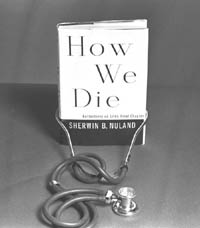
A GIFT FOR THE DYING
Suzanne Egle
![]()
![]() Sometimes
the days are long and frustrating, she says as she drives home.
Sometimes
the days are long and frustrating, she says as she drives home.  Itís
not the patients she has a hard time coping with, but the long drives,
the paperwork and bureaucracy. "Patients are no problem, the good stuff
comes from knowing you were there and made a difference. Itís the art of
balance," Curtis says. "We love what we do, but it takes its toll."
Itís
not the patients she has a hard time coping with, but the long drives,
the paperwork and bureaucracy. "Patients are no problem, the good stuff
comes from knowing you were there and made a difference. Itís the art of
balance," Curtis says. "We love what we do, but it takes its toll."
![]()
![]() "You
meet people," she says. "Some are very difficult, especially the younger
people." Managing a patientís pain is a primary concern of the hospice
nurse. Once she treated a single mother with three children who would tolerate
extreme pain so she could pick up her kids from school. She didnít want
to be groggy from any medicine. "That was gut wrenching," says Curtis.
Another was in such excruciating pain she couldnít even move her. "It was
heartbreaking," Curtis says.
"You
meet people," she says. "Some are very difficult, especially the younger
people." Managing a patientís pain is a primary concern of the hospice
nurse. Once she treated a single mother with three children who would tolerate
extreme pain so she could pick up her kids from school. She didnít want
to be groggy from any medicine. "That was gut wrenching," says Curtis.
Another was in such excruciating pain she couldnít even move her. "It was
heartbreaking," Curtis says.
![]()
![]() Sometimes
the family doesnít cooperate, and she must spend most of the visit acting
as referee. Whether dealing with pain management or the emotional roller
coaster ride the families experience, Curtis listens sympathetically and
helps them cope.
Sometimes
the family doesnít cooperate, and she must spend most of the visit acting
as referee. Whether dealing with pain management or the emotional roller
coaster ride the families experience, Curtis listens sympathetically and
helps them cope.
![]()
![]() "The
worst and the best of family dynamics comes out," she says.
"The
worst and the best of family dynamics comes out," she says.
![]()
![]() When
a patient dies, the bereavement coordinator is responsible for following
the family for 13 months, sending them cards on the anniversary of their
death, on the wedding anniversary and their birthday, as well as quarterly
mailings to the family that explain the stages of grief. The hospice program
also offers a free support group to the surviving relatives to help them
cope with the grieving process.
When
a patient dies, the bereavement coordinator is responsible for following
the family for 13 months, sending them cards on the anniversary of their
death, on the wedding anniversary and their birthday, as well as quarterly
mailings to the family that explain the stages of grief. The hospice program
also offers a free support group to the surviving relatives to help them
cope with the grieving process.
![]()
![]() In
addition to providing patients and their families with the physical needs
such as hospital beds, bath nurses, attendants, and medicines, the hospice
team distributes a manual entitled "Gone from my Sight" that describes
the dying process and what to expect from it.
In
addition to providing patients and their families with the physical needs
such as hospital beds, bath nurses, attendants, and medicines, the hospice
team distributes a manual entitled "Gone from my Sight" that describes
the dying process and what to expect from it.
"A SAFE PLACE TO VENT"

![]()
![]() Curtis
wishes more people would take advantage of the positive benefits of hospice,
but many donít enter hospice until late in their illness because they are
unaware of its existence. And doctors have such a hard time coming to terms
with end of life issues, she says.
Curtis
wishes more people would take advantage of the positive benefits of hospice,
but many donít enter hospice until late in their illness because they are
unaware of its existence. And doctors have such a hard time coming to terms
with end of life issues, she says.
![]()
![]() "They
look at hospice not as a continuum of care, but as a failure on their part,"
she says. So the average hospice stay is only 24 days when it could be
at least six months. "Itís an atrocity and a disservice to the people of
the United States that this service exists and so few people know about
it and are deserving of it," says Curtis.
"They
look at hospice not as a continuum of care, but as a failure on their part,"
she says. So the average hospice stay is only 24 days when it could be
at least six months. "Itís an atrocity and a disservice to the people of
the United States that this service exists and so few people know about
it and are deserving of it," says Curtis.
![]()
![]() The
hospice philosophy also focuses on the role of spirituality and the meaning
of death in different cultures. There is a universal familiarity with the
aspects of death whatever the culture, and by keeping an open mind and
listening carefully one can begin to understand the messages of the dying.
"Itís critical to be sensitive to that," Curtis says.
The
hospice philosophy also focuses on the role of spirituality and the meaning
of death in different cultures. There is a universal familiarity with the
aspects of death whatever the culture, and by keeping an open mind and
listening carefully one can begin to understand the messages of the dying.
"Itís critical to be sensitive to that," Curtis says.
![]()
![]() Curtis
often attends a support group with her colleagues. Sometimes itís hard
to get everyone together, she says, but it gives them an opportunity to
talk about how someone has touched them.
Curtis
often attends a support group with her colleagues. Sometimes itís hard
to get everyone together, she says, but it gives them an opportunity to
talk about how someone has touched them.
![]()
![]() "Itís
a safe place to vent," she says. "How can I explain my day to my husband?"
Only those people who do that kind of work get it, she says. "Itís a whole
different mindset in dealing with the dying. Sometimes people donít understand
it."
"Itís
a safe place to vent," she says. "How can I explain my day to my husband?"
Only those people who do that kind of work get it, she says. "Itís a whole
different mindset in dealing with the dying. Sometimes people donít understand
it."
![]()
![]() Two
weeks later Curtis learns that her 91 year old lung cancer patient died.
"You know itís going to happen, but it still upset me," Curtis says sadly.
Two
weeks later Curtis learns that her 91 year old lung cancer patient died.
"You know itís going to happen, but it still upset me," Curtis says sadly.
To learn more about Hospice contact:
The National Hospice Organization (1-800-658-8898) www.nho.org
The Hospice Association of America (1-202-546-4759) www.hospice-america.org